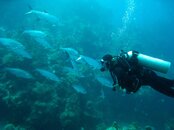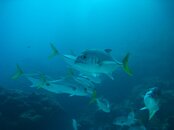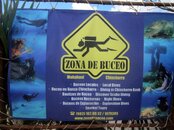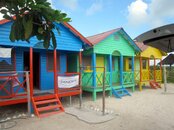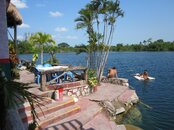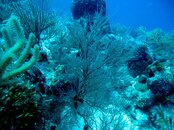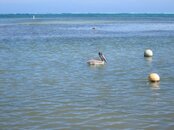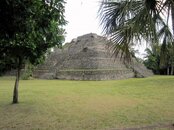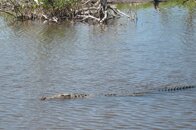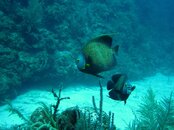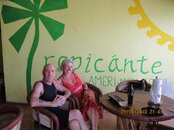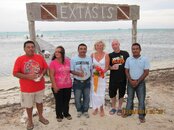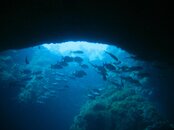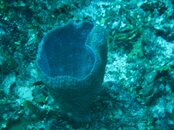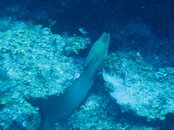Until recently Mahahual was a very small community consisting mostly of fisherman. In 1998 a cruise ship pier was built a couple miles north of town. Now the town and port area has a population of about six hundred. The Costa Maya port and the town of Mahahual should not be confused even though the cruise industry sometimes borrows the towns name and calls the port New Mahahual. Ten thousand pod people may be in port but few venture out of the artificial Mayan theme park. The few day visitors desperate for a local vibe roll through town on golf carts, dune buggies, bicycles, and buses. The town and strangers seem to oddly occupy similar space-time but not the same dimension. Images from Mimsy Were the Borogroves come to mind. The visitors are kind of cute all huddled together for safety waiting for snorkeling class or for plastic kayaks, or standing on the reef while fly fishing. A few miles west of the port is a parking lot with a couple dozen coach busses that send cruisers to remote adventure.
People from all over the world have made Mahahual their home, but it is still very easy to find yourself in a situation where English is not spoken. The ability to speak Spanish will add to your comfort and enjoyment. There are only a couple small shops that target the tourist, like the gelato seller offering product at three dollars a scoop.
Medical facilities are a couple hours away. The ATM is at the Pemex a few miles west of town and available if the power does not fail.
The Maya Luna hotel has four fairly new concrete beach front cabanas with screen for windows and that perfect Caribbean ocean view fully complete with sounds and smells passing through day and night. The bed and pillows were very firm, the staff helpful, grounds well kept, kitchen excellent, and the margaritas strong. The roof terrace where light pollution is almost unknown is perfect for seeing Where the Sky Begins. Being a few miles south of town made for restful and quiet lodging during the activities leading up to Fat Tuesday, which was held on Friday due to the sharing of paraphernalia with other villages. Many of the lodgings outside of town are off-grid and visitors may want to mentally prepare for an ecological stay. Any of the hotels in town would provide good service if your expectations are appropriate.
Much of the coast from Punta Herrero to Xcalak has breakers about a thousand feet from shore. Inside the reef the snorkeling is excellent. By Punta Herrero I saw many large hard coral in the lagoon with tissue that was healthy within inches of the surface.
The dive master at Zona de Buceo (a.k.a. Dive Zone) is the most professional I have had. Jorge gave undivided attention to his clients and had an uncanny ability to see their needs. The shop is in town, easy to find, and will rinse and store gear. Divers who are able to assemble their own gear, exit and re-enter small boats in rough open water will greatly enjoy diving the pristine sites along the coast. There is a dive operation in Mahahual with the cruise ship contract. Any of the half dozen dive operations in Mahahual can probably provide good service; a few even have their own boats.
The coral at Mahahual is the most impressive I have seen. The structures are often dramatic white sand chutes sided by tall walls encrusted with large hard coral that is healthy from the sand often to the water surface. From my small sampling it appears the topography is generally steeply sloping.
We made the trip to Chinchorro for two dives. The east wind was quite strong which made the trip over a long two and one-half hours. Diving at Chinchorro has been described as like Mahahual only everything is larger. The visibility was not great, probably because of the weather. The surface interval was spent on Cayo Centro at the park ranger station watching crocodile in the lagoon.
At Xcalak we used a fishing boat and dive guide to make two dives, La Chimenea and La Poza (Tarpon Hole). The first dive was supposed to be a swim-through and exiting a chimney but the guide missed the entrance. The coral along the wall did not seem healthy. La Poza, our second dive, has been referred to as a destination dive. We entered at the top of a chute in ten feet of water, descended to about sixty feet, left the chute and immediately entered the current. Following the sloping wall we were able to duck into crevasses and gently glide through schools of large Tarpon and Jacks. We saw many rays, both Spotted Eagle and Southern. The current took us through a trench to a most impressive pillar.
When heading out of the lagoon for the first dive the waves were high enough to top the bow twice. During one of the dousings the outboard motor quit. Im convinced that if the skipper had not been able to restart the motor and keep the boat straight the minnow would be lost. Many times we hit the wave trough hard. When the boat returned through the cut it was like surfing. My next purchase will be a Dive Alert signal horn.
At Bacalar, on hwy 307, you may want to pull over at Cenote Azul. If you have your own tanks and gear you can dive for free from the side of the restaurant.
More info about Xcalak diving: XTC DIVE CENTER | Recreational Scuba Diving in Xcalak, Costa Maya Mexico
Another option for a perfect vacation would be to stay about forty minutes north of Mahahual at the Mayan Beach Garden. The owners are absolutely wonderful, gracious people. Arrange through them to coordinate diving with one of the original dive masters in the community. She has two small boats, tanks, weights, and a compressor.
Expect when diving the southern coast of the Mexican Caribbean yours may be the only dive boat in sight. Diving some of the sites require purchasing a park wrist band that the operator will provide. Those seeking the most remote adventure might take their gear north about three hours into the Sian Kaan.
If you have ventured north into the Sian Kaan you may want to take a few hours (and deet) to stop and watch the wildlife. The only traffic on the sand road will be a few fisherman from Punta Herrero, a military patrol, a fly fisherman, and bird watcher. There are very few that have dwellings along the shore.
I have read posts on Scubaboard that try to describe the difference between diving resorts and resorts with diving. Diving the southern coast may lean more toward diving adventure. I predict that within a few years the Mahahual area will become heavily traveled by divers.
One disheartening revelation this trip provided was the huge amount of garbage generated by man and dumped into the ocean. We visited remote areas where the garbage is not collected like it is in the resort areas and we saw the piles washing up on shore.
The closest international airport is at Cancun. If you are not disposed toward renting a car and driving the 4+ hours south, there are scheduled bus routes from the ADO stations in Cancun and Playa del Carmen to Mahahual. Travel time on the bus from Cancun is about six hours. If you find yourself in Chetumal, the Caribe bus has a route to Mahahual and perhaps on down to Xcalak.
Mahahual? Wear the fox hat
People from all over the world have made Mahahual their home, but it is still very easy to find yourself in a situation where English is not spoken. The ability to speak Spanish will add to your comfort and enjoyment. There are only a couple small shops that target the tourist, like the gelato seller offering product at three dollars a scoop.
Medical facilities are a couple hours away. The ATM is at the Pemex a few miles west of town and available if the power does not fail.
The Maya Luna hotel has four fairly new concrete beach front cabanas with screen for windows and that perfect Caribbean ocean view fully complete with sounds and smells passing through day and night. The bed and pillows were very firm, the staff helpful, grounds well kept, kitchen excellent, and the margaritas strong. The roof terrace where light pollution is almost unknown is perfect for seeing Where the Sky Begins. Being a few miles south of town made for restful and quiet lodging during the activities leading up to Fat Tuesday, which was held on Friday due to the sharing of paraphernalia with other villages. Many of the lodgings outside of town are off-grid and visitors may want to mentally prepare for an ecological stay. Any of the hotels in town would provide good service if your expectations are appropriate.
Much of the coast from Punta Herrero to Xcalak has breakers about a thousand feet from shore. Inside the reef the snorkeling is excellent. By Punta Herrero I saw many large hard coral in the lagoon with tissue that was healthy within inches of the surface.
The dive master at Zona de Buceo (a.k.a. Dive Zone) is the most professional I have had. Jorge gave undivided attention to his clients and had an uncanny ability to see their needs. The shop is in town, easy to find, and will rinse and store gear. Divers who are able to assemble their own gear, exit and re-enter small boats in rough open water will greatly enjoy diving the pristine sites along the coast. There is a dive operation in Mahahual with the cruise ship contract. Any of the half dozen dive operations in Mahahual can probably provide good service; a few even have their own boats.
The coral at Mahahual is the most impressive I have seen. The structures are often dramatic white sand chutes sided by tall walls encrusted with large hard coral that is healthy from the sand often to the water surface. From my small sampling it appears the topography is generally steeply sloping.
We made the trip to Chinchorro for two dives. The east wind was quite strong which made the trip over a long two and one-half hours. Diving at Chinchorro has been described as like Mahahual only everything is larger. The visibility was not great, probably because of the weather. The surface interval was spent on Cayo Centro at the park ranger station watching crocodile in the lagoon.
At Xcalak we used a fishing boat and dive guide to make two dives, La Chimenea and La Poza (Tarpon Hole). The first dive was supposed to be a swim-through and exiting a chimney but the guide missed the entrance. The coral along the wall did not seem healthy. La Poza, our second dive, has been referred to as a destination dive. We entered at the top of a chute in ten feet of water, descended to about sixty feet, left the chute and immediately entered the current. Following the sloping wall we were able to duck into crevasses and gently glide through schools of large Tarpon and Jacks. We saw many rays, both Spotted Eagle and Southern. The current took us through a trench to a most impressive pillar.
When heading out of the lagoon for the first dive the waves were high enough to top the bow twice. During one of the dousings the outboard motor quit. Im convinced that if the skipper had not been able to restart the motor and keep the boat straight the minnow would be lost. Many times we hit the wave trough hard. When the boat returned through the cut it was like surfing. My next purchase will be a Dive Alert signal horn.
At Bacalar, on hwy 307, you may want to pull over at Cenote Azul. If you have your own tanks and gear you can dive for free from the side of the restaurant.
More info about Xcalak diving: XTC DIVE CENTER | Recreational Scuba Diving in Xcalak, Costa Maya Mexico
Another option for a perfect vacation would be to stay about forty minutes north of Mahahual at the Mayan Beach Garden. The owners are absolutely wonderful, gracious people. Arrange through them to coordinate diving with one of the original dive masters in the community. She has two small boats, tanks, weights, and a compressor.
Expect when diving the southern coast of the Mexican Caribbean yours may be the only dive boat in sight. Diving some of the sites require purchasing a park wrist band that the operator will provide. Those seeking the most remote adventure might take their gear north about three hours into the Sian Kaan.
If you have ventured north into the Sian Kaan you may want to take a few hours (and deet) to stop and watch the wildlife. The only traffic on the sand road will be a few fisherman from Punta Herrero, a military patrol, a fly fisherman, and bird watcher. There are very few that have dwellings along the shore.
I have read posts on Scubaboard that try to describe the difference between diving resorts and resorts with diving. Diving the southern coast may lean more toward diving adventure. I predict that within a few years the Mahahual area will become heavily traveled by divers.
One disheartening revelation this trip provided was the huge amount of garbage generated by man and dumped into the ocean. We visited remote areas where the garbage is not collected like it is in the resort areas and we saw the piles washing up on shore.
The closest international airport is at Cancun. If you are not disposed toward renting a car and driving the 4+ hours south, there are scheduled bus routes from the ADO stations in Cancun and Playa del Carmen to Mahahual. Travel time on the bus from Cancun is about six hours. If you find yourself in Chetumal, the Caribe bus has a route to Mahahual and perhaps on down to Xcalak.
Mahahual? Wear the fox hat
Last edited:




